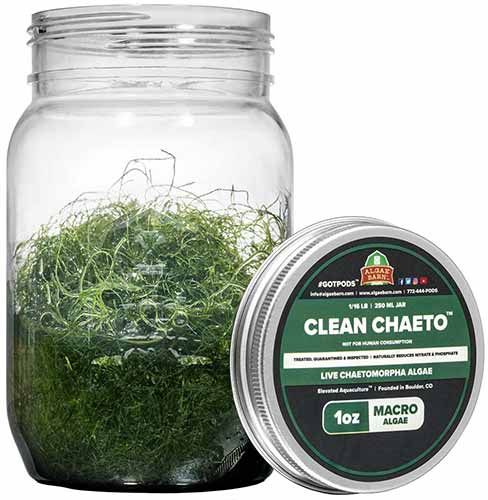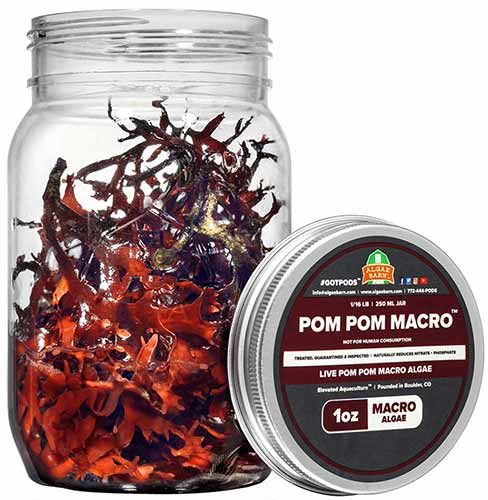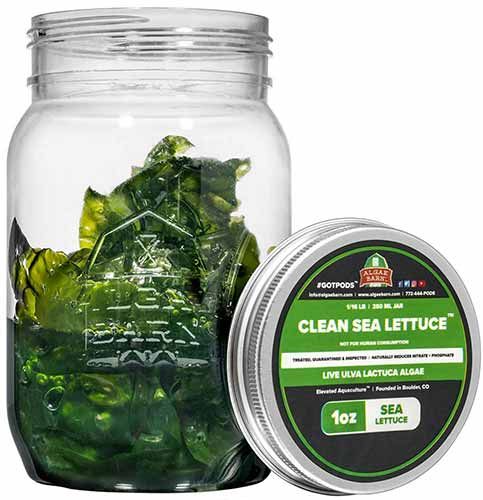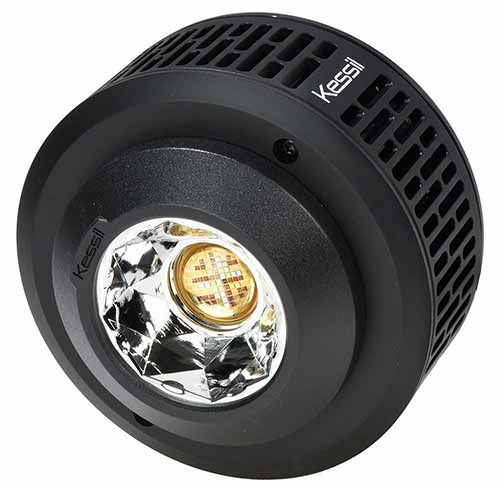Macroalgae is a fantastic way to help control nutrient levels like nitrates in your tank or even to help grow copepods in a controlled environment. But which macroalgae are the best for your system, and how do you get the most out of them?
Chaetomorpha has been the most popular recommendation for quite some time, but is Sea Lettuce actually better macro algae? Continue reading to get a better understanding of the pros and cons of chaeto and sea lettuce and how to properly farm them for the benefit of your corals, fish, and invertebrates.
Types of macroalgae
There are a few types of macroalgae, and they can all be beneficial in their own ways. However, all types of macroalgae help to control the growth rate of nuisance algae; this because the macroalgae are utilizing the nutrients that bad algae need to grow in your display tank.
Chaetomorpha Linum (Chaeto)
Often the most commonly sighted macroalgae in aquarists’ tanks. It is great for breeding different species like copepods or amphipods. It will help to regulate the nitrate and phosphate levels in your saltwater aquarium, which will, in turn, prevent bad algae, like hair algae, from prospering.
Chaeto is commonly considered the go-to macroalgae for use in refugiums and it definitely is a very effective choice. It tends to clump into a ball for easier management but not quite as neatly as I would personally prefer. It can “melt” under too powerful lighting conditions yet strong light can also help it thrive.
Gracilaria Hayi (Pom Pom Gracilaria)
Though this species of macroalgae is one of the most pleasing to look at, it is one of the least effective at removing the nutrients from your reef tank. The most common reason to add this alga is to use it as set dressing.
If you were to put it in a refugium with other macroalgae it will eventually die off as it is outcompeted by more aggressive macroalgae.
Ulva Lactuca (Sea Lettuce)
Sea lettuce is sometimes referred to as the fastest-growing macroalgae, and this can come with a lot of its own benefits. Like chaeto, this green algae works through the nitrates and phosphates in your marine tank that support the growing process of other bad kinds of algae.
It also is great for supporting the diets of various kinds of herbivorous fish in your marine tank. You can easily grab a bit from your refugium and add it to your display tank for herbivores such as Tangs to feed on.
The green macroalgae will also help to stabilize water parameters like the pH in your reef aquarium. The algae will thrive in shallow rocky areas, which makes it perfect for your refugium. It also makes a great forest for copepods to thrive.
It does need a more powerful light for it to grow well which should be considered. I use a Kessil A360x Refugium over my refugium to grow sea lettuce and I’m amazed at the growth. The image at the top of this article is a picture of my refugium packed with sea lettuce and the purple hue is the powerful A360x Refugium light.
Caulerpa Prolifera (Leaf Caulerpa)
Another popular and fast-growing macroalgae. There are many types of caulerpa but Leaf Caulerpa is considered the best for refugiums amongst the caulerpa variations.
It needs to be planted as it has a root system so a sand bed or refugium mud are ideal. It can be planted in the display tank but does grow rapidly so will need to be pruned often.
A problem with leaf caulerpa is that it can reproduce sexually which causes it to die back and decay back into the water column. This is extremely undesirable since it is essentially doing the opposite of what it is used for in a refugium. Instead of sequestering excess nutrients it releases all the nutrients that it collected over type rapidly as it dies off. This can obviously wreak havoc on water quality.
All varieties of caulerpa have the chance of going sexual but fortunately leaf caulerpa is not the most prone to do so. It can be prevented from going sexual if it is pruned back frequently. If you’re more of a lazy reef (like me) you will want to stay away from this particular macroalgae.
What is the best macroalgae for a refugium?
The best macro algae for your marine tank will depend largely on your needs and your own personal preferences. If you are trying to grow macroalgae to be useful in more than one area, then it might be in your best interest to grow sea lettuce. Sea lettuce not only helps to control the nutrients in your saltwater tank, but it can help feed the herbivorous fish and help improve different variables in your water quality.
My pick: Sea Lettuce
While chateo macro algae are useful in controlling the nutrients in your saltwater tank, they can’t stand up against the versatility of sea lettuce. However, if you aren’t looking to work with the fast-growing sea lettuce, it might be in your best interest to use chaeto since it will be easier to manage in your refugium. I’ve switched from Chaeto to Sea Lettuce in my refugium and am blown away. I’m using a Kessil A360x Refugium and my sea lettuce is growing like wild and my display tank is nearly completely algae-free.
However, you need to remember a couple of things when you are using macroalgae to prevent the population of bad algae from getting out of hand. For starters, corals and plants both use similar nutrients as your algae, so if the macroalgae are taking food from the water column from bad algae, it is also affecting your tank. That is why it is important to think of the location of your macroalgae.
Keep your macroalgae in your sump more controlled area. By placing your refugium here, you are doing two things: first, you are allowing your copepods a safe place to grow, and you contain the macroalgae more so than if it was in the main tank. You still might need to add supplements if your nitrates and phosphates are really low, but that should be on a case-by-case basis.
Macroalgae care
Whether you are growing Chaetemorpha or sea lettuce in your refugium, it is important to know the basics of care for the macroalgae. Your macroalgae may be able to withstand large changes in water quality, depending on their type, but you should still take care to provide it with the bare necessities. Macroalga will need the following conditions to thrive, which is another reason why the refugium is so great for growing your algae.
- Salinity – keep the specific gravity around 1.024
- Temperature – the temperature should stay in the high 70s. Aim for a range of 78-86 degrees Fahrenheit
- pH – 7.9-8.2
You will also need to monitor your calcium, magnesium, and iron as best you can. These elements can aid in your specific macroalgae’s growth, but depending on your experience, you may struggle to properly adjust these according to the needs of your algae. Focus on the bulleted pieces and ensure that your algae are getting proper lighting. If you want to try to create a large growth cycle, then find the necessary levels for these elements. Your algae will stay alive and well if the bullets are followed, but you might lose out on max growth if the trace elements aren’t followed specifically.
How to grow sea lettuce, Ulva Lactuca
Growing sea lettuce in your saltwater tank or refugium is actually quite easy due to the hardy nature of the macroalgae species. Place your sea lettuce in an area with moderate water flow and a lot of light. Your lighting is the main source of food for the Ulva Lactuca, so it is important to ensure that it is receiving a good amount consistently.
Ulva Lactuca will also attach to surfaces if given a chance, and this can help increase the spread of the plant throughout the tank and allow for more light to be absorbed than if they had all clumped together. You can even move your live rock between your display and refugium as the sea lettuce attached to it; this will help to encourage the spread of the sea lettuce.
Ulva Lactuca can then easily be moved to your display tank, but that means you will want to use live rock that is easily accessible. Remember always think of the future and use pieces that you can grab at any moment with little need to move organisms or other live rock. We want this process to be as streamlined as possible.
The sea lettuce will grow to fit its space, and that is because it’s highly efficient in its growing process; this is why it is best to focus on growing your sea lettuce in the refugium rather than your display tank.
How fast does sea lettuce grow?
Sea lettuce algae are highly efficient with their growing process. It is considered the fastest growing refugium macroalgae. Most aquarists won’t have to try that hard to get it to grow in their tanks. It has the potential, in a single day, to grow an additional 40 percent of their mass.
The best light to grow sea lettuce
A powerful grow light is the most important factor in growing sea lettuce in your saltwater aquarium. Since sea lettuce enjoys intense light, it is important to place the macroalgae in the refugium where other more light-sensitive species won’t be located. You can program your light to be especially intense in this area.
Like I mentioned previously, I’m using the Kessil A360x Refugium. This isn’t an inexpensive light but it is extremely powerful and since it is an LED light it produces much less heat in the cramped space above my refugium within my tank stand.
If you have a smaller budget and less need I would recommend the Kessil H160 or H80. The H80 is the least powerful of the bunch will have the lowest results but can still get the job done.
I’d caution against some of the bargain grow lights you see on Amazon and some other online retailers. They may output the optimal color spectrum but they likely don’t have the power of something like even the least expensive Kessil. And power is what sea lettuce needs to grow best.
Where to buy sea lettuce
Why is my sea lettuce turning white?
If your normally green macroalgae are turning white, there is most certainly a problem. The correct level of lighting is the most important thing that you can provide 6e macroalgae in your reef tank. The white color is an indication that your green algae are not receiving enough light in your reef tank. Don’t worry; this is easy enough to fix because all you need to do is increasing the intensity of the lighting of your tank’s system.
How long does sea lettuce live?
Sea lettuce will stay alive for only three months but that is okay since it grows so incredibly quickly. The algae will continue to replace itself for your to have a constant supply of macroalgae to help different nutrient levels in your tank.
Final thoughts
Macroalgae, whether it is chaeto or sea lettuce, can help control the population of bad algae such as hair algae by using up the nutrients that they rely on to thrive. You don’t need to worry about the macroalgae’s ability to thrive as much as you need to consider how you are manipulating them to your advantage. Watch your water parameters as they will change, and you will need to make adjustments as you learn to utilize the algae. Finally, make sure your macroalgae’s environment is bright enough for them. It will make a difference in how quickly they are able to populate.







